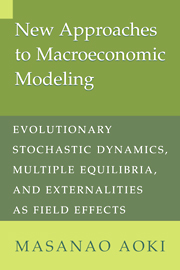 New Approaches to Macroeconomic Modeling
New Approaches to Macroeconomic Modeling Book contents
- Frontmatter
- Contents
- Preface
- Part I Introduction
- Part II Modeling Interactions
- 4 Modeling interactions I: Jump Markov processes
- 5 Modeling interactions II: Master equations and field effects
- 6 Modeling Interactions III: Pairwise and Multiple-Pair Interactions
- Part III Hierarchical Dynamics and Critical Phenomena
- Appendix
- References
- Index
6 - Modeling Interactions III: Pairwise and Multiple-Pair Interactions
Published online by Cambridge University Press: 05 May 2010
- Frontmatter
- Contents
- Preface
- Part I Introduction
- Part II Modeling Interactions
- 4 Modeling interactions I: Jump Markov processes
- 5 Modeling interactions II: Master equations and field effects
- 6 Modeling Interactions III: Pairwise and Multiple-Pair Interactions
- Part III Hierarchical Dynamics and Critical Phenomena
- Appendix
- References
- Index
Summary
So far, we have concentrated on modeling a large collection of microeconomic agents subject to field-effect externality. We have shown that we can specify the transition rates for microeconomic units in such a way that they satisfy the detailed balance conditions, and that we establish Gibbs distributions as equilibrium distributions for the state of finite-state Markov chains, and we have investigated the implications of multiple equilibria for the resulting macroeconomic dynamics.
In this chapter, we discuss another circumstance under which Gibbs distributions arise by modeling pairwise externality or interaction among microeconomic units. Unlike field effects, unit i is assumed to interact with unit j, which can be specified as one of / ‘s neighbors or can be anonymous, as in Cornell and Roll (1981). When more than a single pair is involved in interaction, then we have multiple-pair interactions. A history of past interaction patterns may affect the current interaction coefficients, causing complex patterns of interactions to evolve over time.
Pairwise or multiple-pair interactions
Ising model
Ising used interaction among magnetic dipoles located at neighboring sites to model phase transitions and spontaneous magnetization in 1925. See Ellis (1985, p. 131). He put magnetic dipoles at d-dimensional regular lattice sites. Later this regular lattice structure was relaxed and a graph structure was introduced with dipoles located at nodes of the graph. This type of neighborhood interaction was later formalized as a Markov random field which has a well-developed literature. Markov random field models have many applications outside physics, including sociology and economics. See Spitzer (1975) and Kindermann and Snell (1980).
- Type
- Chapter
- Information
- New Approaches to Macroeconomic ModelingEvolutionary Stochastic Dynamics, Multiple Equilibria, and Externalities as Field Effects, pp. 171 - 183Publisher: Cambridge University PressPrint publication year: 1996


